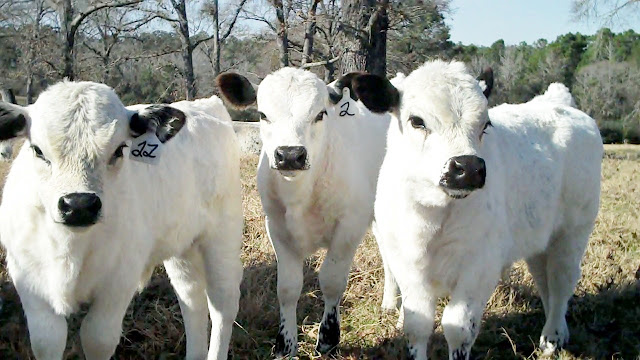Excerpt from: The American Farmer, Vol. XIV, 1858, Pg. 57
 |
| J.West's S.S. Carter sired heifer calf from an El Presidente daughter |
". . . The cattle of ancient days were chiefly valued for dairy qualities or for draft, and were only fatted when they would milk or draw no longer. The greater number of breeds were large boned and ill shaped, greedy eaters and slow at ripening, while as very little winter food was raised except hay, the meat laid on in summer was lost or barely maintained in winter. Fresh meat for six months of the year was a luxury only enjoyed by the wealthiest.
First class farmers salted down an old cow in autumn, which with their flitches of bacon, supplied their families with meat until the spring. Esquire Bedel Gunning, in his Memorials of Cambridge, relates that when Dr Makepeace Thackeray settled in Chester about the beginning of the present century, he presented one of his tenants with a bull calf of a superior breed. On his inquiry after it in the spring,the tenant replied, "Sir, he was a noble animal, we killed him at Christmas and have lived upon him ever since."
The improvement of the breeds of live stock is one of the events which distinguish the progress of English Agriculture during the last century. Prominent among those who labored to this end was Robert Bakewell of Dishley, the founder of the Leicester sheep. He also had his favorite long horn cattle and black cart horses, and though he failed in establishing these he taught others how to succeed.
Surrounded by the titled of Europe, he talked upon his favorite subject, breeding, with earnest yet playful enthusiasm, there utterly indifferent to vulgar traditional prejudices, he enumerated those axioms which must be the cardinal rules of the improvers of live stock. He chose the animals of the form and temperament which showed signs of producing the most fat and muscle, declaring that in an ox all was useless that was not beef, that he sought by pairing the best specimens, to make the shoulders comparatively little, the hind quarters large, to produce a body truly circular, with as short legs as possible, upon the plain principle that the value lies in the barrel and not in the legs, and to secure a small head small neck and small bones.
As few things escaped his acute eye he remarked that quick fattening depended much upon amiability of disposition, and he brought his bulls by gentleness to be as docile as dogs.
. . . But fine boned animals were not in fashion when Bakewell commenced his career, and to the majority of people it seemed a step backwards to prefer well made dwarfs to uncouth giants.
. . . In 1798 the Little Smithfield Club was established for exhibiting fat stock at Christmas time in competition for prizes, with a specification of the food on which each animal had been kept. This Society has rendered essential service by making known the best kind of food, and by educating graziers and butchers in a knowledge of the best form of animal.
In 1806, in defiance of Mr Coke's toast, "Small in size and great in value," a prize was given to the tallest ox. In 1856 a little ox of the Devon breed of an egg like shape, which is the modern beau ideal, gained the Smithfield gold medal in competition with gigantic Short Horns, and Herefords of Elephantine proportions. In 1855 a large animal of Sir Harry Verney's was passed over without even the compliment of a commendation -- because he carried on his carcass too much offal and more threepenny than nine penny beef."
(Note: Reprint of J.West 2007 topic)


